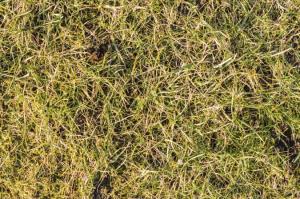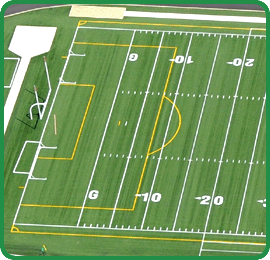Recurring drought in California has led to parched fields, brown lawns, and drying reservoirs, with no end in sight. Severe water restrictions are in effect, with mandatory cuts of 25% in many areas.
Homeowners are restricted to watering two to three times a week, threatened with steep fines for over-watering. The California legislature called for the removal of 50 million square feet of lawn across the state. Lawns are particularly thirsty, accounting for over a third of urban water use. Each square foot of live grass can guzzle 55 gallons of water a year. With the incentive of generous rebates ($2 to $3.75 per square foot) for ripping out those lush green lawns, many homeowners are replacing turf with drought-friendly or native plants or cacti; others layer mulch, bark, pebbles or gravel. But of course cactus and gravel don’t make a friendly surface for children’s play or games of soccer.
Increasingly homeowners are choosing artificial turf — though it is banned in some areas, such as Pasadena and Glendale. Business is booming for turf companies, who say their product is much improved over the stiff AstroTurf of old — developed by Monsanto in the 1960s and most famously installed in Houston’s Astrodome.

Newer products are softer and more grasslike. Synthetic turf is marketed as a water-saving, weed-free alternative, safe for pets and children’s play areas, as well as for year-round, all-weather sports fields and putting greens. But it’s not cheap. The average cost per square foot can run $7 to $10, fully installed. It requires a drainage layer and multi-layer backing system, with a granular infill. Replacing a basic 15′ by 20′ area (300 square foot yard) could run $2100 to $3000.
Typically the turf is made of plastic polymers consisting of polyethylene fibers. Some such as SYNLawn are more environmentally friendly than traditional petroleum-based polymers, using biobased polymers from soybean oil, with added ‘Celceram’ (a recycled product from coal) to add strength and durability. The infill for artificial turf consists of sand or more typically tiny black granules — pebbles of Crumb Rubber from pulverized recycled car and truck tires — which gives it more bounce, particularly for use on athletic fields. New crumb rubber must be periodically added. There are organic alternatives for infill, such as coconut fiber and cork.
Environmental and Health Concerns

Synthetic turf is not without controversy. Certainly the faux turf does require less water and maintenance, with decreased use of fertilizers, pesticides and herbicides, and no need for gas-powered, carbon-emitting lawn mowers. Plus grass clippings are one of the largest components of municipal solid waste. Yet plastic in the fake grass (frass to some) will decompose over time, leaching chemicals into soil and storm water. Tests of the leachate water from the Connecticut Department of Environmental Protection found levels of zinc, manganese, and chromium harmful to aquatic organisms. The New York State Department of Environmental Conservatism conducted a study of leached chemicals from crumb rubber found zinc, aniline and phenol released above groundwater standards. Whereas natural grass filters rainwater, synthetic turf may lead to excessive water runoff during heavy rainfall. In addition, artificial turf does not support natural biodiversity; it forms an ecological dead zone. Nothing eats it or lives on it.
The artificial turf may heat up the yard as much as 80 degrees (F) hotter than natural grass, leading to unpleasant rubber odors, and the potential for heat-related illness. The fields can become so hot that they need to be watered to cool them to acceptable levels.
Artificial turf has an expected lifespan of 8 to 20 years. Where will the carpet-like sheets go afterward, but to disposal at the local landfill? One football field may contain 120 tons of crumb rubber pellets. Some fear that we are creating a future solid waste problem. The turf companies currently making money off sales will most likely be out of the picture by the time this becomes a significant issue.
Is it safe? The Synthetic Turf Council consistently maintains that the surfaces are safe, but the EPA and Consumer Product Safety Commission have undertaken only “limited” studies, and have said that more testing needs to be undertaken. The crumb rubber used for infill contains heavy metals and chemicals such as benzene, benzothiazole, chromium, cadmium, mercury, lead, halogenated flame retardants, carbon black, and polycyclic aromatic compounds, among others listed by the EPA. This particulate matter may be absorbed through direct skin contact, ingestion or inhalation. Gases and volatile organic compounds (VOCs) are emitted and may be inhaled as the material heats up in the sun. Benzothiazole (BZT) is one of the compounds that easily volatizes from rubber; it “exerts acute toxicity and is a respiratory irritant and dermal sensitizer.” In particular, rubber dust gets on athlete’s or children’s hands, where it can be ingested. According to USA Today, several studies have found “potentially harmful lead levels in turf fibers and in rubber crumbs,” exceeding the federal hazard levels of 400 ppm for lead in soil (which is already significantly higher than California’s standard for lead in soil, 80 ppm.
Consider that artificial turf is used in thousands of sports fields across the country, from professional football stadiums to high school arenas as well as elementary and preschool playgrounds. There are particular concerns for athletes who spend significant time in close contact with artificial turf. There are some indications of allergic responses. How is the turf sanitized of bodily fluids (saliva, blood, sweat, vomit or urine), as well as animal droppings from birds or dogs? Some manufacturers use antimicrobial chemicals bound to the plastic polymer, but these silver-based compounds break down as well. Artificial turf can cause abrasive wounds and scrapes for athletes impacting the surface. In addition, the black beads (turf bugs) get in the clothes, hair, skin, nose and mouth of athletes playing on the surfaces. They are tracked home after becoming embedded in clothes, shoes and socks.
There are individual cases of athletes, particularly goalkeepers, with cancer, Hodgkin’s lymphoma and thyroid issues, but no systematic statistical correlation between artificial turf and cancer. In her Science News article, Science may get sidelined in artificial turf debate, Beth Mole notes that, “a closer look at the data may ease many fears; they show that artificial turf is generally safe.” And yet there are well documented health risks to tire fabrication workers exposed to chemicals and dust from rubber. The Penn State Center for Sports Surface Research has collected links to a number of scientific studies on the human health issues of synthetic turf “A natural experiment is being conduced in which thousands of children are being exposed on playing fields to rubber, said David Brown, former chief of Environmental Epidemiology and Occupational Health at Connecticut’s Department of Health.
New Jersey’s fact sheet, Be Aware of Artificial Turf Hazards, summarizes health concerns and states that, “Issues of toxicity, movement, heat, cost, friction, sanitation, lifespan, maintenance, warranty, disposal costs, odor, loss of habitat, combustibility, should be thoroughly addressed before any decision to purchase is made.” New York City and the Los Angeles Unified School District stopped installing crumb rubber fields in parks. The U.S. Environmental Protection Agency concluded that comprehensive conclusions on health could not be reached without additional data.
Artificial turf is marketed as safe for pets. If there are concerns for humans, what about pets, who may spend much of their life walking and lying on a synthetic back yard? When they lick their paws, they certainly consume traces of rubber and plastic. And they track particles into the house as well. On a sizzling summer day, the turf may become uncomfortably hot for dogs to walk on as well.
What to do when the data is unclear? The New Jersey Environmental Council data sheet concludes, “When it comes to synthetic turf, the most sensible approach may be to follow the precautionary principle of assuming something involving chemicals is hazardous until scientific evidence proves that it is not.” That may be an over-reach, however, in cases that involve the well-being of children, it is better to err on the side of safety. Nevertheless, it is clear that more data and scientific testing are needed to fully understand potential health and environmental impacts of synthetic turf. However, basic precautions involve limiting play time on hot days, removing rubber pellets from clothing, and washing hands thoroughly after contact with synthetic turf surfaces.
Further reading:
The Use of Recycled Tire Materials on Playgrounds and Artificial Turf Fields, EPA report.
A Scoping Level Field Monitoring Study of Synthetic Turf Fields and Playgrounds, 2009 U.S. Environmental Protection Agency.
Be Aware of Artificial Turf Hazards, New Jersey Work Environmental Council Fact Sheet.
Synthetic Turf: Health and Environmental Impacts, Penn State Center for Sports Surface Research.
Synthetic Turf: Health Debate Takes Root, by Luz Claudio, Environmental Health Perspectives, March 2008.
Benzothiazole Toxicity Assessment in Support of Synthetic Turf Field Human Health Risk Assessment, Journal of Toxicity and Environmental Health, Gary Ginsberg, Brian Toal and Tara Kurland, July, 28, 2011.
Frequently asked questions, answered by the Synthetic Turf Council.
Science may get sidelined in artificial turf debate, by Beth Mole, Science News, April 21, 2015.
How safe is the Artificial Turf your child plays on? NBC News Oct. 8, 2014
Feds promote artificial turf as safe despite health concerns, USA Today, March 16, 2015.
Examining Artificial Turf’s Environmental Issues, by Carol Van Dam Falk, The Connection, January 2013
Artificial Turf: Exposures to Ground Up Rubber Tires – Athletic Fields, Playgrounds, Garden Mulch, Environment and Human Health
Toxic Turf: Movement grows against synthetic turf by Jennifer McKim and Christina Jedra. Huffington Post, May 9, 2015










